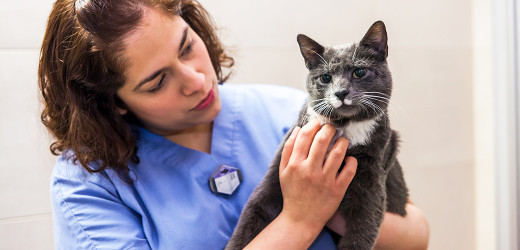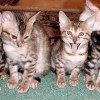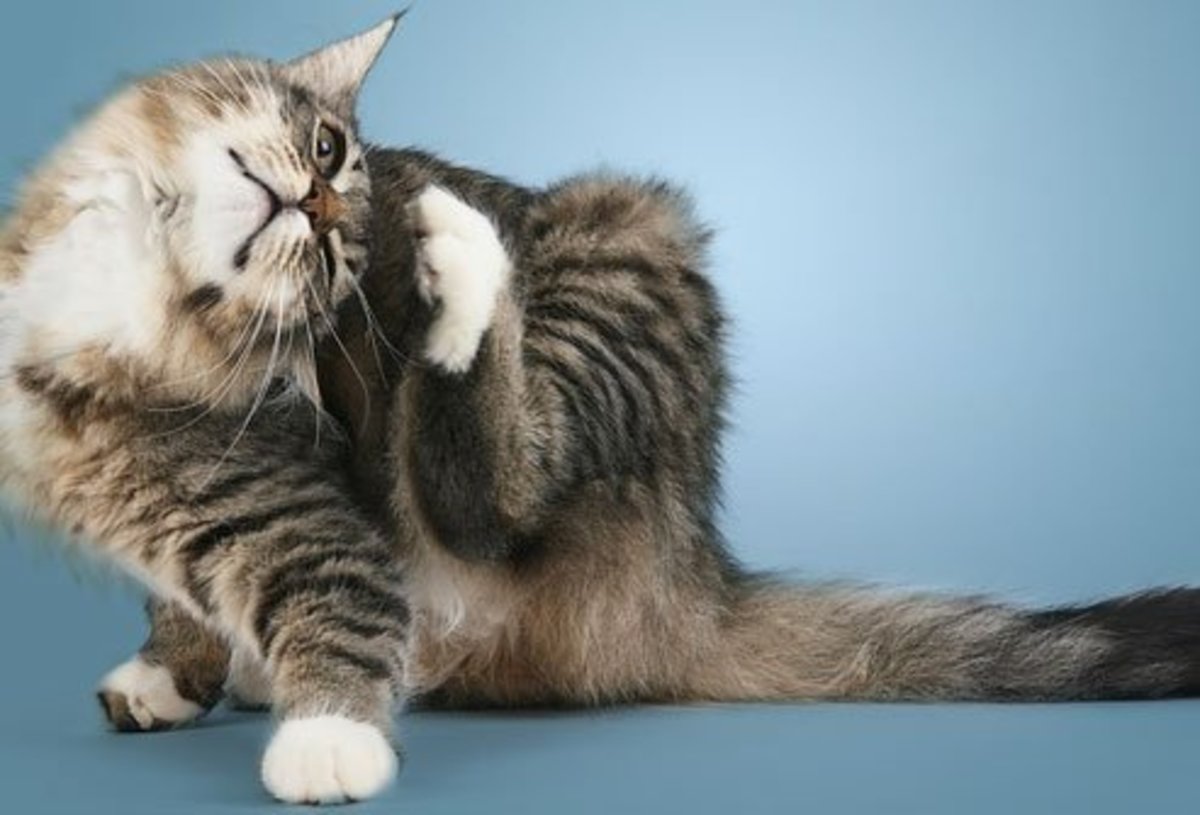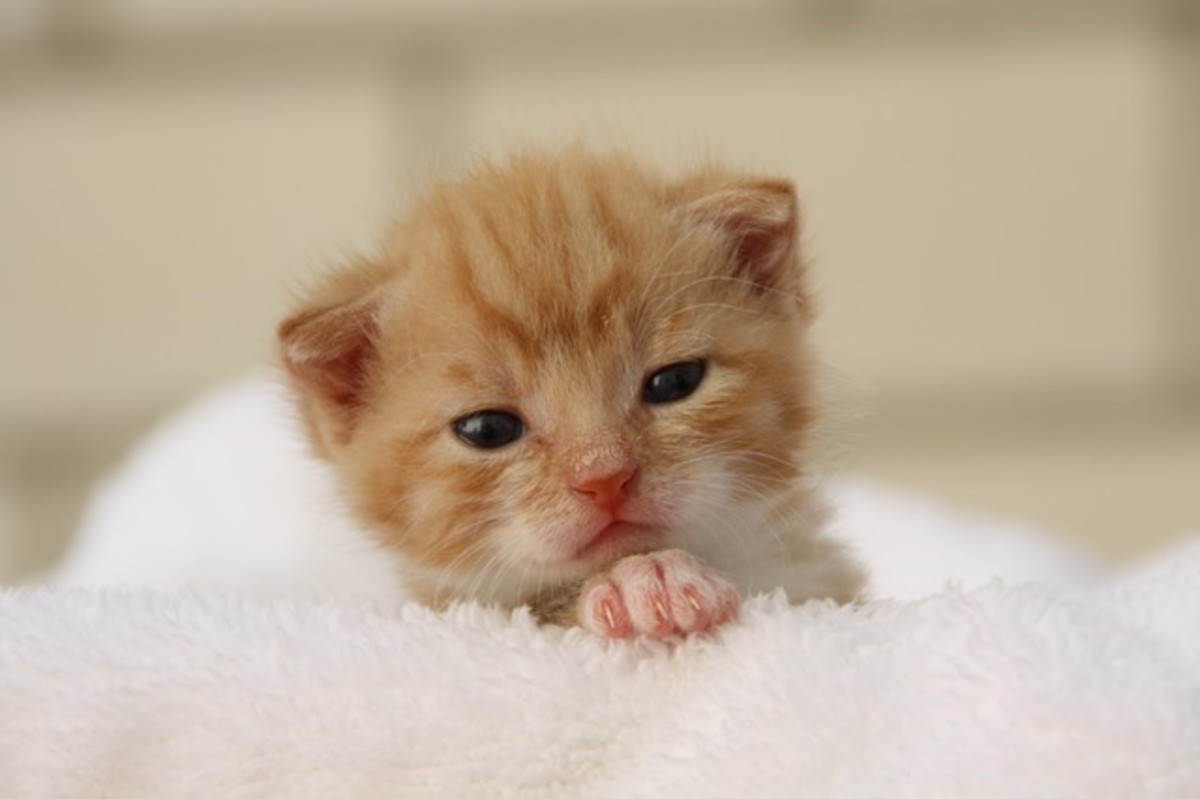Cat Disease that is Treatable

Cat disease that is treatable usually falls into one of three categories. It can be caused by bacteria, viruses, or protozoa and fungi. These infectious diseases are often transmitted from one cat to another by contact with infected feces and other bodily secretions or inhalation of germ-laden droplets in the air. Some can be transmitted through the genital tract when cats mate and others, by contact with spores in the soil which get into the body through the respiratory tract or a break in the skin.
For our purpose here, we will discuss mainly cat disease that is treatable through preventive measures as well as the medical treatment that is effective in slowing down or defeating the disease.
FELINE BACTERIAL DISEASES
Feline Infectious Anemia
This disease is most common in male cats one to three years of age. it is caused by a microorganism that attaches itself to the surface of red blood cells and destroys these cells, producing hemolytic anemia.
Many cats in the general population carry the infection in a latent form. A cat with this disease usually exhibits 103-106 degrees fever, suffers a rapid loss of appetite, appears weak and lethargic, and may show signs of anemia (pale gums and mucous membranes). Your vet can make the diagnosis by finding Hemobartonella organisms on a smear of blood taken from the cat.
Tetracycline is effective in about half the cases. Many cats improve on their own and treated cases frequently relapse. Cats who recover become carriers. The cat's general condition should be improved by appropriate nutritional support. If the anemia is severe, blood transfusions are suggested. Steroids are sometimes prescribed when the infection cannot be told apart from other forms of hemolytic anemia that respond to steroids.
Salmonella
This disease is caused by a type of salmonella bacteria that produces gastrointestinal infection in susceptible animals. It usually afflicts kittens that live in crowded, unsanitary surroundings and cats whose natural resistance has been weakened by a virus infection, malnutrition, or some other stress.
The general signs of infection are high fever, vomiting and diarrhea, dehydration, and weakness. Death will occur in half the cases. Diagnosis is made by identifying salmonella bacteria in stool cultures or in the blood, feces, and infected tissues of cats suffering an acute infection.
Several different antibiotics are effective against salmonella bacteria. Most strains are sensitive to Chloromycetin. The disease can be prevented by housing cats under sanitary conditions where they can be well-cared for and fed.
Tetanus (Lockjaw)
This disease is caused by a bacteria called Clostridium tetani. It is rare in cats because they possess a high natural immunity.
Bacteria enter the skin through an open wound such as a bite or puncture. The tetanus bacteria is found in soil contaminated by horse and cow manure.
Symptoms appear as early as a few days after the injury but can be delayed for as long as several weeks. Tetanus bacteria grow best in tissues where the oxygen level is low. The ideal environment is a deep wound that has healed over or one in which there is dead tissue heavily contaminated with filth.
Tetanus cannot be treated at home. Fatalities may be avoided by prompt early veterinary care. Tetanus antitoxins, antibiotics, sedatives, intravenous fluids and care of the wound alter the course for improvement. The disease can be prevented by prompt attention to skin wounds.
Tuberculosis
This disease is caused by the tubercle bacillus. Three strains can produce the disease in man, but only the bovine type can infect the cat.
Tuberculosis in cats is usually acquired by ingesting infected cow's milk or by eating contaminated uncooked beef. Even though there has been a steady decline in tuberculosis with the elimination of this disease from dairy herds, it has not been completely wiped out.
Bovine Tuberculosis is generally a gastrointestinal problem. A common finding is a low-grade fever with chronic wasting and loss of condition in spite of good care and feeding. Abscesses form in the intestinal lymph nodes and liver and lung infection occurs. Sometimes an open wound becomes infected, leading to skin involvement with draining sinuses, and a discharge containing the bacteria. It causes a persistent cough, shortness of breath, and the production of bloody sputum.
The diagnosis is made by finding the tubercle bacilli in the feces, sputum, or in drainage from a wound. Treatment involves antituberculous drugs and is difficult and prolonged. The hazard to human health makes euthanasia the wisest choice.
FELINE VIRUS DISEASES
Feline Viral Respiratory Disease Complex
These diseases are highly contagious and are one of the most common infectious disease problems a cat owner is likely to encounter.
It has been recognized that two major viral groups are responsible for the majority of clinical upper respiratory infections in cats. The first group is the herpesvirus group, which produces Feline Viral Rhinotracheitis (FVR). The second group is the Calicivirus group which produces the Feline Calici Viral Disease (FCV).
There are two distinct stages of the Feline Respiratory disease complex. They are the acute stage followed by the chronic carrier stage.
In the acute stage, there is significant variation in the severity of illness among affected cats. Some have only mild symptoms, while in others the disease progresses rapidly and can sometimes be fatal.
The disease is transmitted from cat to cat by direct contact with infected sputum, nasal or eye discharges, and by contaminated litter pans and water bowls. It can also be transmitted by human hands and rarely by air-borne droplets. Clinical signs usually appear two to 17 days after exposure and reach their maximum of ten days later.
The first signs are fever and bouts of sneezing possibly followed by nasal and/or eye discharge. At first, it is clear. Later it can be mucoid (mucus-y) or Purulent (pus-y). This signifies secondary bacterial infection. Open-mouthed breathing develops in cats with obstructed nasal passages.
A diagnosis can be confirmed by blood tests. These tests are more important in a multi-cat environment. In these environments, cats suspected of having the disease should be isolated from others. Rest and proper humidification of the atmosphere are important in treating your cat. A warm room and a home vaporizer (preferably cold steam) are recommended.
It is important to encourage food and drink, to keep the cat stronger. Supplemental fluids can be given by cheek pouch. (ask your vet about these). Remove secretions from eyes, nose, and mouth with moist cotton balls. Antibiotics like Chloromycetin or Ampicillin are important in the management of viral respiratory illnesses. These are primarily used to prevent secondary bacterial invaders. When the cat begins to eat and drink on his own, the worst of the danger is over.
Many cats who recover from acute illnesses become chronic carriers. The herpes virus (FVR) lives and multiplies in the lining cells of the throat. During periods of stress, the cat may exhibit signs of a mild upper respiratory illness.
The most effective way to control feline viral respiratory infection is to vaccinate all cats.
Feline Panleukopenia(FPL)
This virus is spread by direct contact with an infected cat or his secretions and by the airborne route. The FPL virus can live in carpets, cracks, and furnishings for at least a year. It is resistant to ordinary household disinfectants.
Signs appear from two to ten days after exposure. They include loss of appetite, depression, and fever (up to 105 degrees). The cat will vomit repeatedly, seem to desire water but not drink it, and might be seen crouching in pain over his water bowl. Diarrhea will usually occur later on in the disease, appearing yellow and/or blood-streaked.
Detection of FPL early on is of prime importance in the successful treatment of this disease. It is best to consult a vet on a "false alarm" rather than to wait until the disease is full-blown. Supportive measures include fluid replacement, antibiotics, nutrition maintenance, and occasionally blood transfusions. Immune serums are available and are effective especially when given early on in the disease. Vaccination is the most effective method for preventing serious infection.
Feline Leukemia Virus Disease Complex (FeLV)
This virus may produce an active or chronic illness in cats. It is also the most important cause of feline cancer and contributes to the severity of several other cat diseases.
The initial illness usually lasts two to 16 weeks. The signs are variable. They may include fever, apathy, loss of appetite, weight loss, constipation, diarrhea and vomiting. Some cats develop enlarged lymph nodes while others pale mucus membranes from anemia.
A small number of cats develop cancer months to years after exposure. Lymphosarcoma is the most common variety. Painless masses in the abdomen or enlargement of lymph nodes in the groin, neck, or chest are common symptoms. Cancer may spread to the eye, brain, skin, kidney, or other tissues producing a variety of symptoms. Leukemia is another malignant manifestation. It can be defined as the rapid and uncontrolled growth of white blood cells.
FeLV can be very difficult to diagnose, and usually requires multiple blood tests followed by other diagnostic studies (ex: bone marrow exam, a biopsy of the lymph node) to confirm the presence of the disease.
Cancers produced by FeLV are not curable, however early diagnosis may allow successful relief (but not a cure) from the disease. Some relief measures include the administration of steroids, antibiotics, vitamin-mineral supplements, transfusions, and anti-cancer drugs. Cats that respond to the medications may be made more comfortable and their lives may be prolonged.
FUNGUS DISEASES
Systemic fungal diseases are not common in the cat. They tend to occur in chronically ill or poorly nourished animals.
Cryptococcosis, Nocardiosis, and Blastomycosisare are diseases caused by fungi that live in the soil and organic material. Respiratory symptoms resemble those of tuberculosis. They are chronic cough, recurrent bouts of pneumonia, difficulty in breathing, weight loss, muscle wasting, and lethargy. A fever may also be present.
Fungal diseases are difficult to recognize and treat. X-rays, biopsies, and fungus cultures are used to make the diagnosis. Systemic fungus infections do not respond to conventional antibiotics and require intense veterinary management.
PROTOZOAN DISEASES
Coccidiosis
This protozoan (one-celled animal) disease usually produces infection in young kittens. It is transmitted from cat to cat usually through feces containing oocysts that are ingested. Other animals and birds can act as intermediate or transport hosts.
Coccidiosis in kittens usually is a mild disease. However, if sanitation is poor, a larger number of oocysts can be ingested, producing a significant illness. The illness usually lasts 7-10 days and diarrhea is the main sign of infection. In more severe cases weakness, dehydration and anemia can be present.
Effective treatment for diarrhea is Kaopectate. A severely dehydrated or anemic cat may need to be hospitalized for fluid replacement and/or blood.
Toxoplasmosis
Cats are likely to acquire this infection from consuming infected birds or rodents, or by ingesting oocysts in contaminated soil or feces. People (and cats) can also get this disease from eating raw or undercooked pork, beef, mutton or veal that contains toxoplasma organisms.
Toxoplasmosis usually contains no symptoms, however, when symptomatic it affects the brain, lymphatic system, and lungs. Signs include fever, lethargy, loss of appetite, weight loss, diarrhea, coughing, and difficulty breathing.
Serologic blood tests will show whether a cat has ever been exposed. A positive test in a healthy cat indicates that he has acquired active immunity and is unlikely to be a source of human contamination.
This disease is difficult to recognize in the cat. Effective medications are available but should be used only under veterinary supervision. Toxoplasmosis can be prevented by keeping a cat from roaming and hunting, and by thoroughly cooking all fresh meat (maintaining 140 degrees Fahrenheit throughout)
It is important to recognize that all Cat diseases that are treatable are not equal. Some may require simple and effective treatments to fight the disease, while others may only provide comfort and prolong the quality of life for a finite amount of time. It is your decision to do what you think is right for your cat.
References: The Cat Owner's Home Veterinary Handbook by Delbert G. Carlson, D.V.M and James M. Giffin, M.D.
- Is Your Vomiting Cat Sick?
It is a fact that cats vomit more easily than most other animals and frequently this action represents a flushing out of toxins from the body rather than an imminent illness.
- Cat Health Problems
Common cat health problems range from simple inconveniences to life-threatening accidents and illnesses. If you notice any unusual behavior in your cat or kitten (especially things like not eating, constipation, lethargy, or a dull coat), you should





